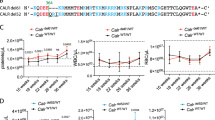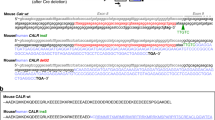Abstract
The Wiskott-Aldrich syndrome protein (WASP; encoded by the gene WAS) and its homologs are important regulators of the actin cytoskeleton, mediating communication between Rho-family GTPases and the actin nucleation/crosslinking factor, the Arp2/3 complex1. Many WAS mutations impair cytoskeletal control in hematopoietic tissues, resulting in functional and developmental defects that define the X-linked Wiskott-Aldrich syndrome (WAS) and the related X-linked thrombocytopenia2 (XLT). These diseases seem to result from reduced WASP signaling, often through decreased transcription or translation of the gene3,4,5,6,7,8. Here we describe a new disease, X-linked severe congenital neutropenia (XLN), caused by a novel L270P mutation in the region of WAS encoding the conserved GTPase binding domain (GBD). In vitro, the mutant protein is constitutively activated through disruption of an autoinhibitory domain in the wild-type protein, indicating that loss of WASP autoinhibition is a key event in XLN. Our findings highlight the importance of precise regulation of WASP in hematopoietic development and function, as impairment versus enhancement of its activity give rise to distinct spectra of cellular defects and clinical phenotypes.
This is a preview of subscription content, access via your institution
Access options
Subscribe to this journal
Receive 12 print issues and online access
$209.00 per year
only $17.42 per issue
Buy this article
- Purchase on Springer Link
- Instant access to full article PDF
Prices may be subject to local taxes which are calculated during checkout



Similar content being viewed by others
References
Machesky, L.M. & Insall, R.H. Signaling to actin dynamics. J. Cell Biol. 146, 267–272 (1999).
Snapper, S.B. & Rosen, F.S. The Wiskott-Aldrich syndrome protein (WASP): roles in signaling and cytoskeletal organization. Annu. Rev. Immunol. 17, 905–929 (1999).
Kolluri, R., Tolias, K.F., Carpenter, C.L., Rosen, F.S. & Kirchhausen, T. Direct interaction of the Wiskott-Aldrich syndrome protein with the GTPase Cdc42. Proc. Natl. Acad. Sci. USA 93, 5615–5618 (1996).
Stewart, D.M. et al. Studies of the expression of the Wiskott-Aldrich syndrome protein. J. Clin. Invest. 97, 2627–2634 (1996).
Zhu, Q. et al. Wiskott-Aldrich syndrome/X-linked thrombocytopenia: WASP gene mutations, protein expression, and phenotype. Blood 90, 2680–2689 (1997).
MacCarthy-Morrogh, L. et al. Absence of expression of the Wiskott-Aldrich syndrome protein in peripheral blood cells of Wiskott-Aldrich syndrome patients. Clin. Immunol. Immunopathol. 88, 22–27 (1998).
Shcherbina, A., Rosen, F.S. & Remold-O'Donnell, E. WASP levels in platelets and lymphocytes of Wiskott-Aldrich syndrome patients correlate with cell dysfunction. J. Immunol. 163, 6314–6320 (1999).
Lemahieu, V., Gastier, J.M. & Francke, U. Novel mutations in the Wiskott-Aldrich syndrome protein gene and their effects on transcriptional, translational, and clinical phenotypes. Hum. Mutat. 14, 54–66 (1999).
Dale, D.C. et al. Mutations in the gene encoding neutrophil elastase in congenital and cyclic neutropenia. Blood 96, 2317–2322 (2000).
Parolini, O. et al. Expression of Wiskott-Aldrich syndrome protein (WASP) gene during hematopoietic differentiation. Blood 90, 70–75 (1997).
Facchetti, F. et al. Defective actin polymerization in EBV-transformed B-cell lines from patients with the Wiskott-Aldrich syndrome. J. Pathol. 185, 99–107 (1998).
Miki, H., Sasaki, T., Takai, Y. & Takenawa, T. Induction of filopodium formation by a WASP-related actin-depolymerizing protein N-WASP. Nature 391, 93–96 (1998).
Kim, A.S., Kakalis, L.T., Abdul-Manan, N., Liu, G.A. & Rosen, M.K. Autoinhibition and activation mechanisms of the Wiskott-Aldrich syndrome protein. Nature 404, 151–158 (2000).
Higgs, H.N. & Pollard, T.D. Activation by Cdc42 and PIP(2) of Wiskott-Aldrich syndrome protein (WASp) stimulates actin nucleation by Arp2/3 complex. J. Cell Biol. 150, 1311–1320 (2000).
Rohatgi, R., Ho, H.Y. & Kirschner, M.W. Mechanism of N-WASP activation by CDC42 and phosphatidylinositol 4, 5-bisphosphate. J. Cell Biol. 150, 1299–1310 (2000).
Prehoda, K.E., Scott, J.A., Dyche Mullins, R. & Lim, W.A. Integration of multiple signals through cooperative regulation of the N-WASP-Arp2/3 complex. Science 290, 801–806 (2000).
Rudolph, M. et al. The Cdc42/Rac interactive binding region motif of the Wiskott Aldrich syndrome protein (WASP) is necessary but not sufficient for tight binding to Cdc42 and structure formation. J. Biol. Chem. 273, 18067–18076 (1998).
Abdul-Manan, N. et al. Structure of Cdc42 in complex with the GTPase binding domain of the Wiskott-Aldrich syndrome protein. Nature 399, 379–383 (1999).
Mullins, R.D., Heuser, J.A. & Pollard, T.D. The interaction of Arp2/3 complex with actin: nucleation, high affinity pointed end capping, and formation of branching networks of filaments. Proc. Natl. Acad. Sci. USA 95, 6181–6186 (1998).
Elsner, J., Roesler, L., Emmendoerffer, A., Lohmann-Matthes, M.-L. & Welte, K. Abnormal regulation in the signal transduction in neutrophils from patients with severe congenital neutropenia: relation of impaired mobilization of cytosolic free calcium to altered chemotaxis, superoxide anion generation and F-actin content. Exp. Hematol. 21, 38–46 (1993).
Dustin, M.L. & Cooper, J.A. The immunological synapse and the actin cytoskeleton: molecular hardware for T cell signaling. Nature Immunol. 1, 23–29 (2000).
Coakley, G., Iqbal, M., Brooks, D., Panayi, G.S. & Lanchbury, J.S. CD8+, CD57+ T cells from healthy elderly subjects suppress neutrophil development in vitro: implications for the neutropenia of Felty's and large granular lymphocyte syndromes. Arthritis Rheum. 43, 834–843 (2000).
Geller, D.S. et al. Activating mineralocorticoid receptor mutation in hypertension exacerbated by pregnancy. Science 289, 119–123 (2000).
Lathrop, G.M. & Lalouel, G.M. Easy calculations of LOD scores and genetic risks on small computers. Am. J. Hum. Genet. 36, 460–465 (1984).
Cottingham, R.W., Idury, R.M. & Schäffer, A.A. Faster sequential genetic linkage computations. Am. J. Hum. Genet. 53, 252–263 (1993).
Dib, C. et al. A comprehensive genetic map of the human genome based on 5,264 microsatellites. Nature 380, 152–154 (1996).
Schwartz, M. et al. Mutation spectrum in patients with Wiskott-Aldrich syndrome and X-linked thrombocytopenia: identification of twelve different mutations in the WASP gene. Thromb. Haemost. 75, 546–550 (1996).
Devriendt, K. et al. Skewed X-chromosome inactivation in female carriers of dyskeratosis congenita. Am. J. Hum. Genet. 60, 581–587 (1997).
Egile, C. et al. Activation of the Cdc42 effector N-WASP by the Shigella flexneri IcsA protein promotes actin nucleation by Arp2/3 complex and bacterial actin-based motility. J. Cell Biol. 146, 1319–1332 (1999).
Carson, M.J. Ribbons 2.0. J. Appl. Crystallogr. 24, 958–961 (1991).
Acknowledgements
We thank Y. Benoit, E. Baeten, F. Van Aelst and M. Holvoet for patient materials; R. Rohatgi and J. Peterson for discussions; D. Nelson for the anti-WASP antibody; and L. Notarangelo for the XLT cell line; and K. Vanstraelen and X. Bossuyt for help. K.D. and P.V. are Senior Clinical Investigators of the Fund for Scientific Research–Flanders (Belgium) (FWO-Vlaanderen). A.S.K. is supported by a fellowship from the Damon Runyon-Walter Winchell Foundation. M.K.R. acknowledges support from the National Institutes of Health (PECASE program), Arnold and Mabel Beckman Foundation and Sidney Kimmel Foundation for Cancer Research.
Author information
Authors and Affiliations
Corresponding authors
Rights and permissions
About this article
Cite this article
Devriendt, K., Kim, A., Mathijs, G. et al. Constitutively activating mutation in WASP causes X-linked severe congenital neutropenia. Nat Genet 27, 313–317 (2001). https://doi.org/10.1038/85886
Received:
Accepted:
Issue Date:
DOI: https://doi.org/10.1038/85886
This article is cited by
-
Heterogeneous genetic landscape of congenital neutropenia in Korean patients revealed by whole exome sequencing: genetic, phenotypic and histologic correlations
Scientific Reports (2022)
-
Gastrointestinal Disorders Associated with Primary Immunodeficiency Diseases
Clinical Reviews in Allergy & Immunology (2019)
-
Phenotype-based gene analysis allowed successful diagnosis of X-linked neutropenia associated with a novel WASp mutation
Annals of Hematology (2018)



